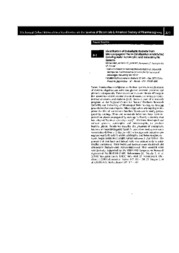Identification of endophytic bactéria from micropropagated yacon (Smallanthus sonchifolius) crowing under autotrophic and Heterotrophic systems.
Identification of endophytic bactéria from micropropagated yacon (Smallanthus sonchifolius) crowing under autotrophic and Heterotrophic systems.
Author(s): MORAES, R. M.; MELO, I. S. de; JOSHI, V. C.; SUMYANTO, J.; SAMOYLENKO, V.; ILIAS, M.
Summary: Yacon, Smallanthus sonchifolius, an Andean species. is a rich source of dictetíc oligofructans with low glucose content. proteins and phenolic compounds. These constituents have shown efficacy in the prevention of diet-related ehronic diseases, including gastroin-testinal disorders and diabetes |1,2|. Yacon is part of a research program at the National Center for Natural Products Research (NCNPR) and University of Mississippi Field Station to develop new alternative root crops for Mississippi while attempting to im-prove the diet of low incorne families. Yacon can be easily propa-gated by cultings. Virus and nematode infections have been re-ported on plants propagated by cuttings in Brazil. a country that hás adopted Yacon as specialty crop [3|. We have developed two culture systems. autotrophic and heterotrophic, to produce healthy plants. Herem we describe the presence of endophytic bactéria m micropropagated Yacon. In auxin free media, new roots were induced. Overa 15day period. the average root mduction per expiam was 5.45 to 8.75 under autotrophic and heterotrophic cul-tures, respectively. Root lenglh vaned between 3 and 60mrn. The presence of root hairs and lateral roots was noticed only in auto-trophic condilions. These beneficiai bactéria were identified and chemically ctiaracterized. Acknowledgement: This research work was partially supported by the USDA/ARS Cooperative Research Agreement No. 58-6408-2-009. Referentes; |1) Terada S. et ai. (2006] Yakugaku Zasshi 126(8): 665-669. (2| Valentová K. Ulri-chová j. (2003) Biomedical Papers 147: 119-130. [3| Mogor C. et ai, (2003) Acta Horticulturea 597: 311 -313.
Publication year: 2008
Types of publication: Abstract in annals or event proceedings
Unit: Embrapa Environment
Keywords: Autotrophic, Bactéria, Endophytic, Heterotrophic systems, Identification, Micropropagated
Observation
Some of Embrapa's publications are published as ePub files. To read them, use or download one of the following free software options to your computer or mobile device. Android: Google Play Books; IOS: iBooks; Windows and Linux: Calibre.
Access other publications
Access the Agricultural Research Database (BDPA) to consult Embrapa's full library collection and records.
Visit Embrapa Bookstore to purchase books and other publications sold by Embrapa.

